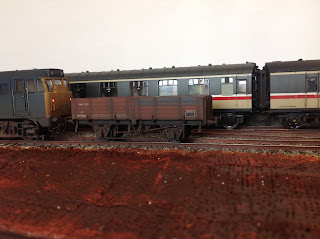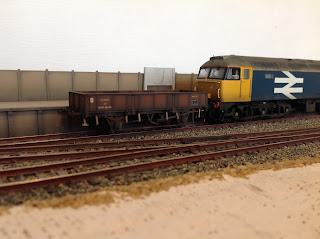Over the last week I finished off a slow burner of a project - weathering and sound fitting a class 31. The model is the newer Hornby model, finished in BR blue with a factory applied weathering. I thought it would be a relatively quick job to weather this locomotive and test out the new Hornby TTS sound decoder range - well how wrong can you be!!! When I first ran the model fresh from its packaging it was awful, and I discovered one of the pick up wires had a broken soldered joint. It was at this point I became familiar with the Hornby design for the bogies, with split side frames - this is a bonkers arrangement and it extremely fiddly to take apart. The solebars seem very flexible to me and I am sure they have warped a little bit. Talk about reinventing the wheel for this arrangement, I do not think this is a very clever design at all and would prefer a more sturdy bogie.
The finished project standing at Charton station, with a short train of intercity liveried mk1 coaches.
I weathered the solebars first, using various shades of weathered black, rust, brake dust, frame dirt and sleeper grime, before resoldering the droppers and reassembling each bogie. The next issue was the sound decoded was not going to fit with the fan in place, so this had to be removed from the locomotive and binned. Once removed the TTS sound decoder was fitted for a test run. It was just rubbish! Running was jerky and all over the place. So I switched the decoder over for a standard Bachmann 8 pin decoder and it ran like a dream. It was obvious the TTS decoder was faulty and a bit of reading on the rmweb revealed this to be a common fault - so I sent it back and duly got a replacment.
Side on view of the finished weathering - the variation on the solebars shows up well in this image.
Whilst waiting for the replacement decoder I masked off the two bogies and added the detailing pack to both ends. This is where I encountered my next problem. I attempted to fit 3 link couplings and found a solid lump of metal sat straight behind the buffer beam! The coupling supplied in the detailing pack is a fairly sturdy metal one, so I super glued this into place to use with 3 link couplings. I then set about dismantling the body of the locomotive, removing the glazing, etc, and weathered the body and the chassis separately.
Here the faded yellow and buffer beam detailing can be seen, included the original coupling.
To the chassis I applied various shades of weathered black, sleeper grime and frame dirt from an airbrush. I wanted to achieve a subtle weathered finish on this one, with a bit of faded blue, but not with chipped paint. For the body I applied some streaks of faded rail blue on the sides and some faded yellow on the cab ends, supplemented by some weathered black, again streaking the body and also around the grills. For this streaking I used a finer 0.3mm air brush that I have recently acquired, from the Iwata Neon range. After this I applied a thinned wash of frame dirt and weathered black over the whole body, allowing it to enter into all the nooks and crannies before wiping most of it away. Following this the body had a few more light passes of sleeper grime, weathered black and frame dirt added.
Some of the first streaks of faded blue on the side of the body.
A bit of faded yellow on the front.
Some of the finer streaks of weathered black, before more weathering using sleeper grime and frame dirt.
The all over wash, showing it applied one the right, with some of it washed away on the left.
Once the masking was all removed I fitted the TTS sound decoder and speaker, which is an extremely tight squeeze even with the fan removed. However, I managed to get it all to fit and reattached the body to the chassis. Feeling rather pleased with myself I fired it up for the first time. Again the running from the TTS decoder was poor, although not as bad as the first time with a faulty decoder. Some googling found out some possible fixes to get rid of the erratic running. It turns out there are two motor settings on the decoder, one is for very slow speed shunting, with the fine motor control being outstanding on this mode. However, the problem is even at full speed it is only going a scale 7mph! The other motor setting is for normal running and the factory settings here still provide a poor performance. Even with some tweaking of the original CV settings for the motor parameters, it still provides a coarse overall performance compared to other decoders.
Running into the station and this is at full speed!
So over the to the sound settings. For £40 it is under half of the price of good quality sound chip - and quite frankly it shows! There is no automatic braking squeal when it is slowing to a halt, and the start up and horn sounds are quite basic. However, the motor idle and acceleration are pretty pleasing. I was quite keen to experiment with TTS sound when it came out. However, the outcome of this model has produced something that will only run well at a crawl, and sounds ok. Next time I would rather save up for a Howes decoder and I suspect I will probably replace this TTS decoder in due course. On another note, I am really chuffed with how the weathering turned out on this one. To my eyes it certainly looks the part, but probably does not quite sound the part (yet!). I must say that for Hornby products I am left less than impressed, both in the design of the locomotive (solebars on the bogies) and the TTS decoder. As for the sounds - see below and judge for yourself!
Start up out of the station - which is definitely the best sequence from the TTS decoder.





















